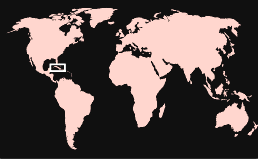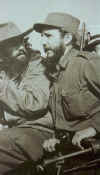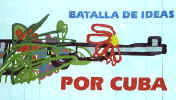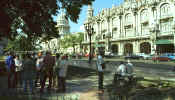Geography
 Cuba is the largest
island in the Caribbean, and nearly as big as all the rest put together.
It is located some 100 miles south of Key West, Florida. Forested
mountains make up a quarter of the island, and fertile plains much of the
rest. The porous limestone geology means large lakes and rivers do not
exist. The climate is subtropical.
Cuba is the largest
island in the Caribbean, and nearly as big as all the rest put together.
It is located some 100 miles south of Key West, Florida. Forested
mountains make up a quarter of the island, and fertile plains much of the
rest. The porous limestone geology means large lakes and rivers do not
exist. The climate is subtropical.
Forests are making a comeback under the Castro regime, but the increasingly
impoverished Cuban citizens appear to be putting a growing strain on the
country's formerly rich coral reefs.
History
Cuba was 'discovered' by Christopher Colombus in 1492, who thought it
was part of Asia. At the time there was a thriving indigenous population,
but disease, murder and slavery made short work of them. All that remains
of their culture is the cigar.
Cuba was from the beginning Spain's most important base in the New World, and
remained so for over 400 years. Although Cuba itself was gold-poor, Mexico
and Peru had plenty, and it passed through Havana on its way to Spain. As
the riches declined, cattle ranching, tobacco and sugar succeeded one another as
the source of Cuba's wealth; the latter required slave labor from Africa, thus
accounting for Cuba's ethnic makeup today.
Although Spain lost most of its New World possessions in the early 19th
century, it held on to Cuba until the bitter end. An increasingly violent
independence struggle brought matters to a head in 1898; the US declared war on Spain, which put up a token resistance before being ushered off the world
stage. Over time, the Cubans gained an independence of sorts, but always
with Uncle Sam looking on. Discontent swelled under the corrupt
dictatorship of Fulgencio Batista, and a loquacious lawyer named Fidel Castro
stepped forward as leader of the resistance by the early 1950s.
war on Spain, which put up a token resistance before being ushered off the world
stage. Over time, the Cubans gained an independence of sorts, but always
with Uncle Sam looking on. Discontent swelled under the corrupt
dictatorship of Fulgencio Batista, and a loquacious lawyer named Fidel Castro
stepped forward as leader of the resistance by the early 1950s.
 The
success of Castro's revolution in 1959 coincided with the height of the Cold
War, and the US saw red. Relations worsened, culminating in Cuba's
nationalization of US businesses
The
success of Castro's revolution in 1959 coincided with the height of the Cold
War, and the US saw red. Relations worsened, culminating in Cuba's
nationalization of US businesses  and
US support of a counter-revolutionary force during the Bay of Pigs
invasion. The Cuban Missile Crisis didn't help, nor did the CIA's attempt
to assassinate Castro with exploding cigars. In the end, Castro announced
he really was a communist and has been thumbing his nose at Uncle Sam ever
since. The Soviet Union may be long gone, but the revolution lives on in
Cuba, at least according to the billboards.
and
US support of a counter-revolutionary force during the Bay of Pigs
invasion. The Cuban Missile Crisis didn't help, nor did the CIA's attempt
to assassinate Castro with exploding cigars. In the end, Castro announced
he really was a communist and has been thumbing his nose at Uncle Sam ever
since. The Soviet Union may be long gone, but the revolution lives on in
Cuba, at least according to the billboards.
People
The population numbers 11 million. Whites (37%) and Blacks (11%) are
outnumbered by the mixed-race population (51%), indicative of the excellent race
relations. The majority of the populace is Roman Catholic, and the
official language is Spanish.
 Cuban
men are so crazy about baseball that they congregate in city parks to argue
about it. They're also quite keen on cigars, a local invention. As
for the women, they are as outgoing and liberated as any of their European or
American counterparts, a striking contrast with the rest of Latin America.
Cuban
men are so crazy about baseball that they congregate in city parks to argue
about it. They're also quite keen on cigars, a local invention. As
for the women, they are as outgoing and liberated as any of their European or
American counterparts, a striking contrast with the rest of Latin America.
The UN ranks Cuba in the 68th percentile in terms of quality of life, based
on life expectancy, education and income; this is near the top of Latin American
countries (only Argentina, Chile and Mexico rank higher).
Economy
Cuba is a middle-income economy, with a GNP per capita of $2,000 per year.
The economy is relatively broad-based when compared with other Caribbean
economies; sugar is the main product, followed by nickel, citrus fruits, tobacco
and, increasingly, tourism. The decline of the Soviet Union let much of
the air out of the Cuban economy, although expansion has resumed.
Cuba's economy is largely
state-controlled. While individuals may, say, own their own personal or
family business or small farm, the government owns everything that's big, and
tries very hard to direct all foreign currency to its coffers. Salaries
for the (majority) state employees are pathetic ($10 equivalent per month), but
in return the government promises a wide array of subsidized goods and services
(including universal education and health care). Unfortunately, these are
increasingly being rationed out of existence. The good news is, nearly
anything is available for those with access to US dollars; the bad news is, many
people have to make do with the official system, which is to say not much.
Tourism is the fastest growing sector of the economy and now the largest
foreign-exchange earner. There were 1.4 million arrivals in 1998, most of
them resort-bound sun-worshippers from Canada and Europe. The US
government maintains tight travel restrictions on its citizens which, when
lifted, will likely result in a gringo flood.
Sources: World Bank (1998 data), Dorling Kindersley
World Reference Atlas, UNDP Human Development Report, Lonely Planet